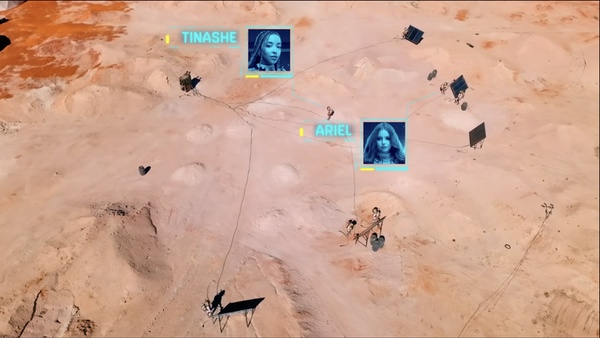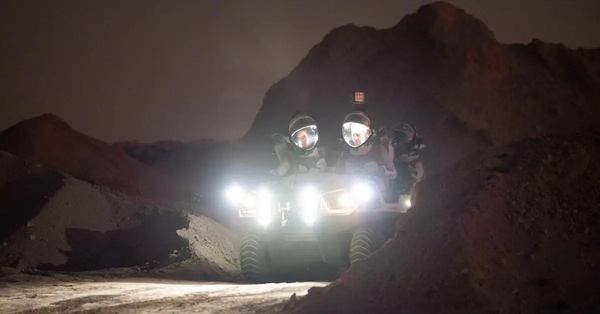Meanwhile, on Mars…
by Dwayne A. Day
Monday, August 7, 2023
We’re in the waning days of the long, hot summer of 2023. The Hollywood writers and actors are on strike, movie debuts are being delayed and, while some new shows are still debuting on streaming services, there will not be much of a fall television season other than game shows and maybe some new cartoons. But “Stars on Mars” is still chugging along.
| “Stars on Mars” is less of a reality TV competition and more of a low-key episodic science fiction show. |
When we last left our seven remaining intrepid celebrities on the Red Planet, they had just been joined by a new batch of celebronauts consisting of a reality TV star, a celebrity chef, a basketball player, and a comedian (Conan O’Brien’s former sidekick, Andy Richter). Of the four, the only one who the first group seemed excited about was the chef, who could finally cook something other than the bland prepackaged food they had been consuming for over a week. They also got a treat in the form of a supply of hot wings and pizza, indicating that their mission planning was not being done by a nutritionist (see “Reality is underrated: Fox’s Stars on Mars takes off,” The Space Review, July 10, 2023.)
But the show had to go on, and soon the newly arrived reality show star had been deemed “not mission critical” and was sent home. The following week, one of the original crew, wrestler Ronda Rousey, became the third person to voluntarily take herself out of the competition. She missed her 18-mont-old child, and she no longer wanted to be there. Last week, Andy Richter was sent home, proving that Mars ain’t the kind of place to raise a comedian.
The original batch of celebrities were not exactly riveting personalities, and the new group is less so. But given its high production values, original premise, and ability to not take itself too seriously, “Stars on Mars” remains watchable, allowing for the lower standards we generally have for summer television. The alleged minor spats between some of the crew are like watching office gossip play out in high-def. Your coworker who always pops popcorn in the office microwave may annoy the heck out of many of you, but that is not the kind of offense that makes for a great story at the bar after work. Similarly, learning that disgraced cyclist Lance Armstrong likes to comment on a young woman’s appearance to annoy her and eats raw bacon out of a container doesn’t make him a particularly engaging supervillain. He’s just a bit of a jerk, and he seems to be okay with that, even if his pre-teen son may be watching him at home and learning all the wrong things to do to get along with people.
“Stars on Mars” is less of a reality TV competition (there’s no monetary prize for being named “The Greatest Star in the Galaxy”), and more of a low-key episodic science fiction show. To date the crises the celebrities faced have included: a wind-damaged communications tower, a ruptured water system, a fire in the greenhouse, alien mold that threatened their food supply, radioactive materials from a crashed spaceship, a meteorite strike on the hab, a crazy computer, and solar flares. These crises may not exactly be scientific, but they are at least sciency—within the realm of plausibility. The show has given its participants new and interesting things to do, and demonstrated that some attributes like physical strength and optimism may not be as important as others, like leadership and determination. Next episode, the crew faces a suspected alien monster in the air ducts. Hopefully they have flamethrowers.
Filmed in a forbidding part of Australia that has served as a good visual backdrop for prior movies and TV shows, the crewmembers do appear to be struggling with many of the challenges, primarily due to having to wear heavy simulated spacesuits while navigating minor obstacles that would otherwise be simple without the suit. None of the challenges so far has really forced them to be clever at problem-solving, although they have had to be resilient.
 The production design and filming for the reality show are top-notch. The show was filmed recently in a remote part of Australia that has served as the location for at least one movie set on Mars. (credit: Fox) |
Drama vs. melodrama on a red planet
Over the past decade there have been a few Mars-themed television shows, most of which undoubtedly owe their existence to the successful 2015 movie The Martian. In November 2016, The National Geographic Channel premiered a show called “Mars”, which included well-researched documentary segments interspersed between dramatic, but dull, scenes of a mission to Mars in the early 2030s. Season two aired in late 2018, and the show was canceled. In 2018, Hulu debuted its series “The First”, produced by and starring Sean Penn, about an astronaut going to Mars, but it never made it past one season. In 2020, Netflix premiered “Away”, about a trouble-plagued mission to Mars that lands during the last episode; a second season that would have taken place on Mars was canceled. Apple TV+ started its alternative history show “For All Mankind” in 2019. The first two seasons, involving lunar settings, were excellent, and the less interesting third season, which became available in 2022, was set on Mars. Although the fourth season started filming early this year, there has been no information about when it may debut and, unless they were completely done with live action filming, it could be on long-term hiatus like much of Hollywood. During that same period, an announced effort to turn Kim Stanley Robinson’s Red Mars/Blue Mars/Green Mars trilogy into a series evaporated. We’re still awaiting a great, or at least pretty good, television drama set on Mars.
| “Stars on Mars” may not have the best or most engaging celebrities, and it may be a little too constrained by its reality-show origins, but what it does have is a hint of The Martian’s heart. |
Real astronauts used to be heroes, but that has faded over time, along with their reputation in movies and television. One of the persistent problems with many of those earlier Mars-based shows is that the drama often stemmed from the Marsnauts being bad at their jobs, hindered by depression, showing a lack of commitment or purpose or focus, or occasionally having deep personal flaws. They often reflected a rather common and lazy trope in current television where characters are given tragic backstories, trauma as a shortcut to making them appear “deep.” Education, training, intelligence, hard work, and competence have rarely been portrayed as interesting character attributes in these shows.
These characters stood in contrast with Matt Damon’s astronaut Mark Watney in The Martian: when faced with adversity, Watney doesn’t mope but instead works hard to solve the problem. In one of his camera monologues he states, “So I got to figure out a way to grow three years’ worth of food here. On a planet where nothing grows. Luckily I’m a botanist. Mars will come to fear my botany powers.” It’s not bravado, it’s confidence imbued by training. Later on, after facing yet another setback, he declares: “In the face of overwhelming odds, I’m faced with only one option: I’m going to science the -hit out of this.” What makes the audience root for him, besides Matt Damon’s natural charm, is the fact that he is determined to never give up. That attitude has often been lacking in television dramas set on Mars, where the harsh environment is treated as secondary—or at least equal to—the inner demons plaguing the characters. Yes, the writers know that the characters still have to start the reactor and free Mars, but first they make them overcome their trauma.
Perhaps this says something about modern American culture, where it is so hard to define what makes a person heroic or admirable. Or maybe it has more to do with how Hollywood writes dramas today, and how much the language of pop psychology has seeped into how we define our world. Until its third season, “For All Mankind” largely avoided that problem and managed to depict characters who could be both flawed and admirable at the same time, like acerbic chief astronaut Molly Cobb, who falsely described herself as a “selfish prick,” but risked her life multiple times to save others, and paid a price for it. Hopefully, when the Hollywood strikes end, we’ll get to see more characters like her on Mars.
“Stars on Mars” may not have the best or most engaging celebrities, and it may be a little too constrained by its reality-show origins, but what it does have is a hint of The Martian’s heart, that what is interesting and defines character isn’t interpersonal sniping, but how people overcome the challenges of Mars. If the editors stopped trying to create drama where it isn’t (at the dinner table, or the exercise room), and focused more on the inherent drama of trying to survive in a hostile environment, it would be a better show than it already is. But we’re not going to get any scripted Mars dramas anytime soon, so you should sit back and enjoy this one while we have it. After this, primetime television will most likely be taken over by game shows, and nobody is going to want to watch “The Price is Right on Mars”.
 “Stars on Mars” is partly a lightweight summer reality show, but it resembles a science fiction show set on Mars and often looks as good as recent dramas about people living on Mars. (credit: Fox) |
For more on recent Mars-themed TV shows, see: see “Red planet reality,” The Space Review, May 30, 2023; “Red zeitgeist: popular entertainment and the settlement of Mars, part 3,” The Space Review, January 16, 2017; “Love and a Red Planet: popular entertainment and the settlement of Mars (part 1),” The Space Review, November 28, 2016; “Red Planet blues: popular entertainment and the settlement of Mars (part 2),” December 5, 2016; “Mars: Bringer of ennui (part 1),” The Space Review, January 21, 2019 and “Mars: Bringer of ennui (part 2)”, January 28, 2019; “Mars ain’t the kind of place to take your kid: Netflix’s ‘Away,’” The Space Review, October 5, 2020.
No comments:
Post a Comment